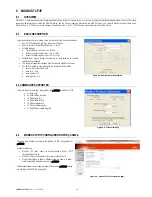
pCOWeb
+030220966 – rel. 1.1 – 12.12.2017
44
9.3
GENERAL INFO AND RESTORING THE DEFAULT SITUATION
The page shown in
Figure 9.g
can be opened to display basic information on the
pCOWeb
and restore the
pCOWeb
default situation.
•
View used/free disk space: shows a summary of the space occupied in
the user memory (
Figure 9.h
);
Size / Used / Avail / Use%: overall size / used / available / % of the
user memory space.
NOTE The space in non-volatile memory reserved for the user is
managed in compressed format; the information saved in this space
(configurations, custom HTML pages, log files, …) will take up less
space than the native size of the file; the values shown in
Figure 9.h
refer physical space occupied by the already compressed information.
Figure 9.g - General info and restore default situation
•
View factory bootswitch parameters: shows a summary of the factory
settings that
pCOWeb
will use if rebooted with the button pressed (see
3.1.2 on page 12);
DEFIP / DEFNETM: IP address / subnet mask;
PROOT / PHTTP / PCAREL / PGUEST: password respectively for
the “root” / “httpadmin” / “carel” / “guest” Usernames in the operating
system running on
pCOWeb
(see 9.8.2 on page 50).
Figure 9.h - Summary of the space available in the user memory
•
View network configuration: shows a summary of the network settings that
pCOWeb
is using, divided between ETH0 / ETH0:1 / ETH0:2 / ETH0:3 (these
can only be displayed if the corresponding logical interface is being used, see section 9.4) / DNS SERVERS / GATEWAY; especially useful when
operating with DHCP: shows the effective information acquired from the server and currently used.
•
Fix permissions of HTML pages and CGI scripts: in the previous firmware versions, once an HTML page or CGI executable was loaded via FTP, this
process needed to be run to automatically attribute the transferred file the rights needed to be recognised by the
pCOWeb
operating system; currently
this is only necessary for executable CGI files.
•
Delete user files and settings: deletes all the settings and files added
by the user, and restores the default situation from a copy located in
the read-only area of the non-volatile memory.
The following options are available (
Figure 9.i
):
No: does nothing
Yes, delete all: also reset the default network configuration
(“DHCP”); in this case, if this setting was not previously used, to
contact
pCOWeb
the button will need to be held when rebooting to
activate the default IP address: 172.16.0.1 (see 3.1.1 on page 11
and 3.1.2 on page 12).
Yes, delete all except network configuration: do not reset the
default network configuration; useful for continuing to connect to
pCOWeb
using the same IP address, recommended if
pCOWeb
cannot be rebooted while holding the button;
Yes, delete logger files only: delete the content of folder
/usr/local/root/flash/http/log containing csv files and graphs
Regardless of the above choice, after confirming with the Submit
button, a report is shown with a request to reboot the
pCOWeb
;
the reboot is required
: some settings will only be reset after
reboot; until that time, the HTML pages will show the incorrect
setting of some parameters (Example: baud rate = 300, see 9.5 a
pagina 46), and these will only be correct after the reboot.
Figure 9.i - Restoring pCOWeb to the default situation
IMPORTANT
If the authentication data to access the configuration
page set by the user is different from the default values (admin / fadmin),
pCOWeb
will request authentication (admin / fadmin) for the configuration
page immediately, starting from the page in response to the deletion of the
user files.
















































